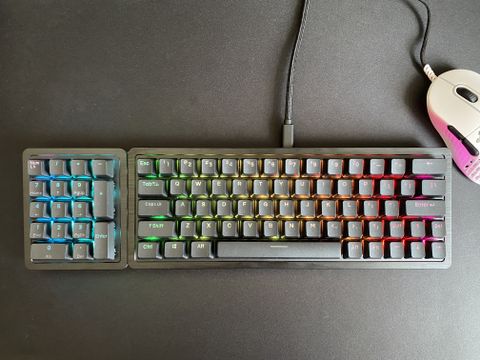TechRadar Verdict
With fantastic build quality, buttery-smooth stabilizers, pre-lubed Mountain switches, and the option for a detachable numpad, the Everest 60 is near perfection.
Pros
- +
Great build quality
- +
Pre-lubed Mountain switches are fantastic
- +
Three-layers of sound dampening
- +
3-pin and 5-pin switch support
Cons
- -
Small right Shift, Alt and FN keys
- -
Slow software
Why you can trust TechRadar
Two-Minute Review
After reviewing the Everest Max recently, Mountain’s latest release, the Everest 60, feels like an evolutionary step up for the company. Almost every conceivable part about the Everest Max has been improved, albeit now in an ultra-compact 60% package.
The Everest 60 features a nearly identical brushed aluminum top plate as the Everest Max, but everything else has received a considerable upgrade. The ABS keycaps are swapped out for higher-quality PBT ones, the hot-swappable PCB now supports both 3-pin and 5-pin switches, there is an excessive amount of padding for soundproofing, and comes pre-installed with Mountain switches that are machine lubed from the factory.
The keyboard still retains what made Everest Max unique, and that is its modularity. You can purchase a separate numpad for $49.99 which can be placed either on the left or right side of the keyboard, adding extra functionality if needed.
The only real knock against the Everest 60 would be its small Shift key on the right side of the keyboard. In order to accommodate the arrow keys, which is pretty uncommon for a 60% keyboard, Mountain chose to shrink the Shift key to a 1u size which could irritate certain users that require better functionality from it.
Pricing
The Mountain Everest cost AED 625 ($140), which is pretty competitively priced for what is an enthusiast keyboard which costs several hundreds of dirhams more. However, unlike the Everest Max, a barebones kit is not available to purchase.
Design and Features
Mountain makes a largely unique proposition with the Everest 60, wherein it has managed to cram in all four arrow keys in its layout, where most 60% keyboard chose to sacrifice it to accommodate other, more often used keys. This could bode well for users who prefer the compact form factor of a 60% keyboard but are deterred by the lack of arrow keys.
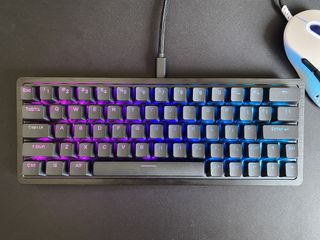
However, in order to include the arrow keys, Mountain chose to shrink the right Shift, Alt, and FN key to a 1u size (or the size of a normal letter key) which could irk some users who are used to a 1.75u size. It took us some time to get used to the smaller Shift key, but even after a week, we still found ourselves hitting the wrong key or having to look down to ensure we were pressing the right key. It is possible to develop muscle memory for it, but it will take considerable time and effort to get used to it.
We would have preferred a larger (or a normal-sized) Shift key even at the cost of sacrificing the Del key and having its function relegated to a FN key combination. This could have eased the learning curve a little bit, while still providing the functionality of the arrow keys.
Besides that, the Everest 60 is a complete home run from Mountain. The build quality is simply fantastic, with the aluminum top plate having little to no flex whatsoever. Mountain has also focused a lot on sound dampening for the keyboard, which some might even consider borderline excessive. While most keyboards would include a layer of foam within the case to aid sound proofing, Mountain goes above and beyond with a silicone layer at the bottom, and two layers of foam covering both sides of the PCB.

This along with the pre-lubed genuine Cherry stabilizers and the Mountain Switches makes for a keyboard that feels buttery smooth. We have tried a lot of mechanical keyboards before, but the Everest 60 truly takes it to the next level.
To further test the prowess of the sound dampening, we swapped the Mountain Switches for the Cherry MX Red switches that came with the Everest Max, which made a significant 'pinging' noise when typed on (due to the lack of lube present on the springs). The pinging noise was still present but was largely reduced to a point where we normally couldn’t hear it unless we really focused on picking up the sound. This means that even if you want to use other third-party switches on the Everest 60, you could get away with it even if they are not lubed correctly (non-lubed switches can also be purchased for a cheaper price).
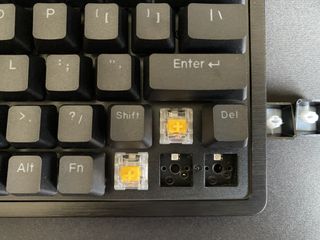
Modding the Everest 60 was a pain free experience, as swapping out the keycaps and the switches was easy and required considerably less effort than what we experienced with the Everest Max. The PCB supports both 3-pin and 5-pin switches which is great as more switch makers are now opting for a 5-pin connection. However, do note that the LEDs are still north-facing, which might not be to everyone’s liking as south-facing LEDs are coming in trend as it provides better illumination.
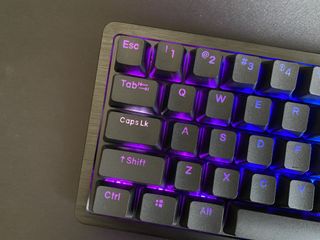
The double-shot PBT keycaps included with the keyboard feel great and of high quality, although we wish some of the keycaps were more clear. It may not be evident in pictures, but some keys like Caps Lock, Tab, or any key that has small lettering have little dark smudges in them that doesn’t allow the RGB lighting to fully shine through. You can swap out the keycaps with any Cherry MX-compatible ones, or you can buy some from Mountain themselves for around $35-$40.

In terms of ergonomics, the Everest 60 still uses the magnetic feets first introduced with the Everest Max. There are four of them in the box, which you can stack against each other to create the desired height, or completely remove them to have the keyboard lay flat. The keyboard also has three USB-C ports on the front, allowing users to wire the keyboard in any way they like. Unfortunately, the USB-C ports can only be used to power the keyboard, so attaching other accessories to the unused ports will not work.
Mountain’s unique selling point with its keyboards are its optional add-ons. For the Everest 60, you can get a numpad for $50, which can be attached either to the left or right side of the keyboard. The numpad connects to the device via the side USB-C port and two plastic clips which slots into the keyboard and keeps it in place. The connection is quite sturdy and the numpad won’t sway even if you move the keyboard or pick it up. This is a great addition for those that want the functionality of a numpad for data crunching or simply wants to set up additional macro keys.
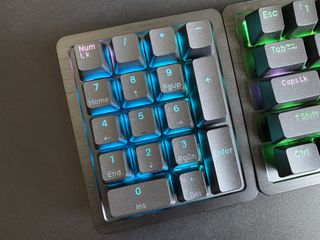
You cannot, however, buy the numpad available for the Everest Max, as it uses another type of locking mechanism. This is rather unfortunate as we would have appreciated the backwards compatibility, even if the size of the numpad and the keyboard don’t align (which is probably why Mountain chose not to make it so). The Everest Max also has an optional media control dock for $60, but that too cannot be attached to the Everest 60 as there is simply no space on the top of the keyboard to accommodate it.
Software and Performance





Mountain’s Base Camp software is an excellent tool to customize the keyboard, if and when it loads correctly. As we mentioned in our Everest Max review, the software is slow to load and can take up several minutes to get into any of the menus. But once you are in, the UI is well laid-out and allows you to tinker around with the options in an easy manner.
With Base Camp, you can adjust the per-key RGB lighting, assign macros, bind keys, set up different profiles, and disable some Windows key combinations.

The Everest 60 comes preinstalled with the Mountain Linear 45 switches, but you can get it in Mountain Tactile 55 and Mountain Linear 45 Speed variants as well. The Linear 45 are quite close to the feel of the Cherry MX Reds as both require 45g of actuation force, but they appear to be a tad bit smoother, and a lot better to type on. The Mountain Switches are pre-lubed directly from the factory, but the job is so immaculate that we would have easily believed it if they claimed it was hand-lubed. The switches are fantastic, and easily some of the best on the market right now. We have tried a number of switches previously, from Cherry MX, Gateron, Kalih, and more, and the Mountain Switches easily ranks among the best.
Typing is great with the switches, and provides for the ever-pleasing ‘thock’, and gaming remains smooth as well with the keys responding quick and efficiently. We phased the keyboard with a few matches on Halo Infinite, and it didn’t have any trouble with executing commands and keeping up with our erratic movements.
Buy this if...
You want a sturdy, highly moddable keyboard
The Everest 60 is immaculately built, and the PCB supports both 3-pin and 5-pin switches which makes it extremely moddable.
You want a competitively priced, enthusiast keyboard
At AED 625, the Everest 60 is extremely competitively priced, and offers features and values of premium enthusiast keyboards that cost far more.
You want the keyboard to be buttery smooth
With three layers of sound dampening, and pre-lubed stabilizers and switches, the Everest 60 is a truly incredible typing experience.
Don't buy this if...
If you require larger keys
The right Shift, Alt and FN keys have been shrunk down to accommodate the arrow keys, which may not be for everyone and requires a massive learning curve.
Mufaddal Fakhruddin is an experienced Editor with a demonstrated history of working in the computer games industry. He is skilled in social media, video idea creation and production, media relations, and journalism.
